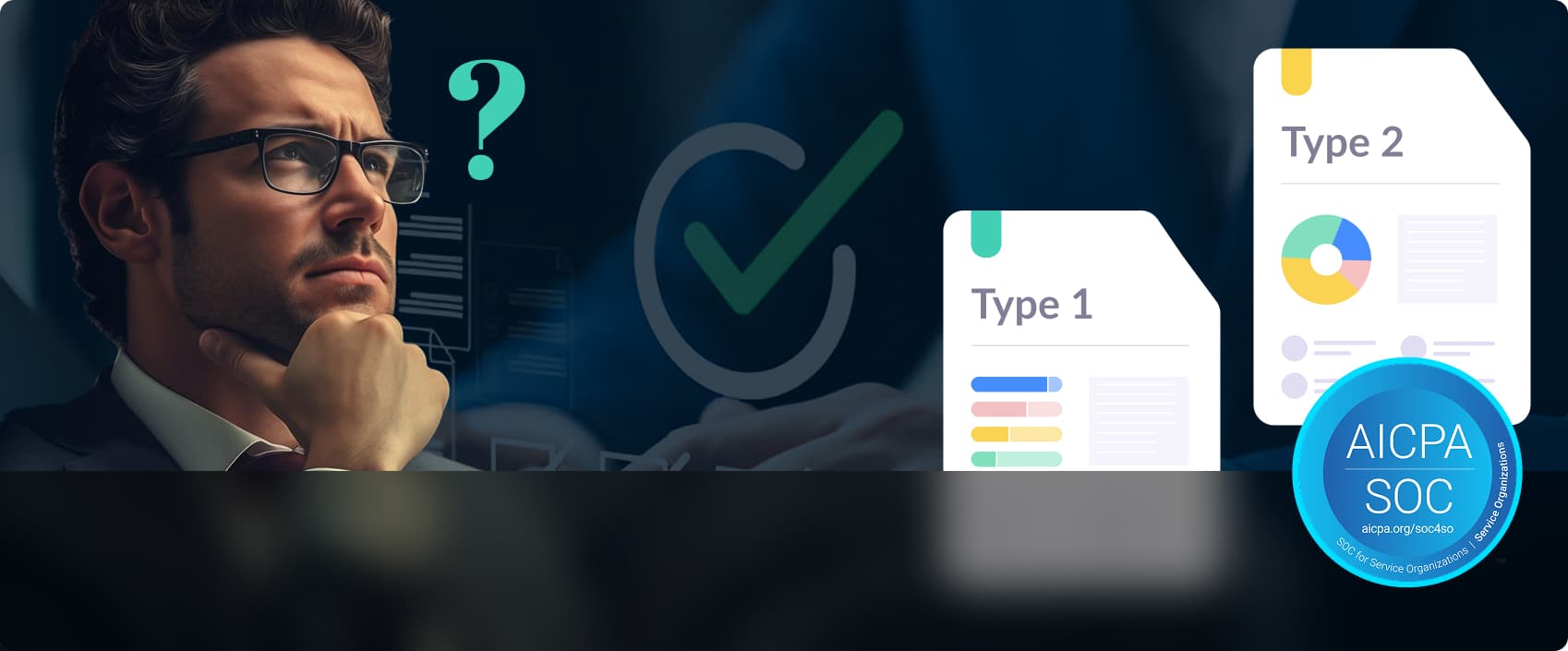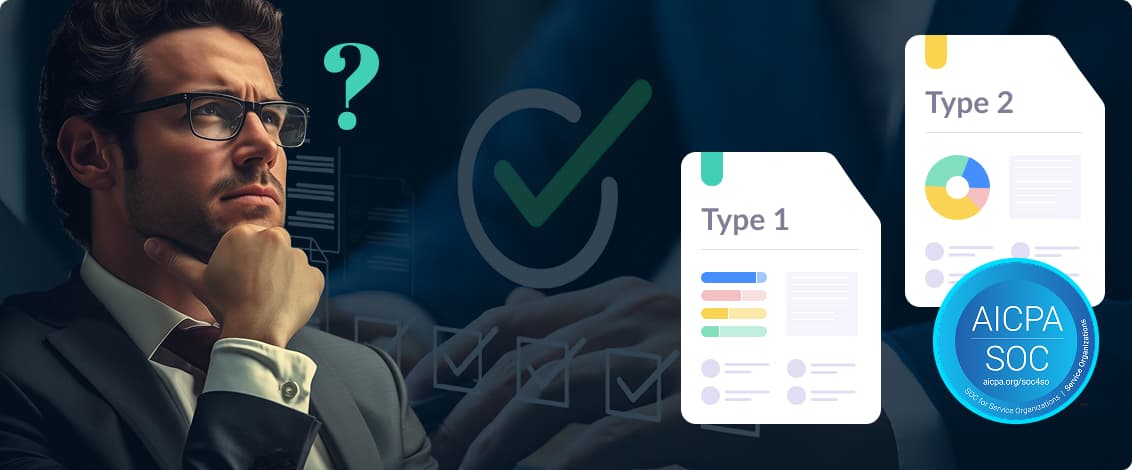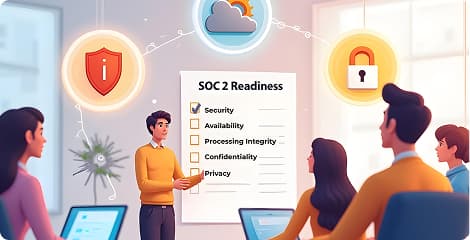SOC 2 audit ensures you are following industry best practices to keep your customer’s data safe, that your systems are running smoothly, and that you’re reliable.
With increasing data breaches and more clients asking for proof of security and operational integrity, having SOC 2 is often the difference between closing enterprise deals or being left behind.
There are two types of SOC 2 reports. Type 1 evaluates whether your controls and policies are designed correctly at a single point in time. Type 2 goes a bit further, it checks how well those controls actually work over several months. Both can help you build trust and earn new opportunities, but the right choice between SOC 2 Type 1 vs. Type 2 depends on your current needs and client expectations.
Let’s decode both to find which one of the SOC 2 audit types fit your business best.
What Is SOC 2 Type 1?
SOC 2 Type 1 is an audit that evaluates whether your company’s controls and security processes are properly designed at a specific point in time. The audit focuses on checking if policies, procedures, and technologies you have in place meet compliance with the Trust Services Criteria (TSC), such as security, availability, confidentiality, processing integrity, and privacy.
Typically, SOC 2 Type 1 provides a snapshot of your system’s control environment, verifying that controls are documented and implemented correctly as of the audit date. It doesn’t test how well these controls operate over time, that’s covered by Type 2.
Startups, early-stage SaaS companies, or organizations new to SOC 2 often choose Type 1 since it can be completed faster, usually within a few weeks, and helps identify gaps before committing to the longer Type 2 audit. It’s ideal for demonstrating to clients and partners that foundational security measures exist.
Pros: Quick to complete, less resource-intensive, useful for initial compliance steps
Cons: Doesn’t prove operating effectiveness over time, provides less assurance to stakeholders
What Is SOC 2 Type 2?
SOC 2 Type 2 is an audit that examines not only whether your controls are properly designed, but also how effectively they operate over a period of time—typically between six months to a year. Unlike Type 1, which provides a snapshot at a single point, Type 2 looks at your company’s security, availability, processing integrity, confidentiality, and privacy controls across a sustained timeframe.
This audit requires a higher level of maturity in your processes. Your team must have fully implemented and consistently followed policies and controls, and you need to provide evidence backing up your ongoing compliance efforts. For this reason, SOC 2 Type 2 is often considered the industry gold standard and signals true enterprise readiness.
Having a Type 2 report tells customers, partners, and regulators that your business not only has strong security measures in place but also maintains them reliably over time. It builds trust, reduces sales friction, and opens doors to larger, more security-conscious clients.
While more time and resource intensive than Type 1, the payoff for SaaS companies is clear: increased credibility, competitive advantage, and a stronger foundation for growth.
Due to the complexity of the process, some companies decide to partner with vendors that can guide them throughout the process of choosing between SOC 2 Type 1 vs. Type 2, and make things easier for them.
Key Differences: SOC 2 Type 1 vs. Type 2
| SOC 2 Type 1 | SOC 2 Type 2 |
|---|---|
| What It Covers | |
| Design of controls at a specific point in time | Design and operating effectiveness of controls over 6–12 months |
| Audit Duration | |
| Few weeks | 6 to 12 months |
| Cost | |
| Lower cost due to shorter audit period | Higher cost due to longer, more detailed audit |
| Effort Required | |
| Moderate — controls must be designed and documented | High — requires consistent implementation & evidence gathering over time |
| Best For | |
| Startups, early-stage companies, MVPs that need quick proof | Mature companies ready to demonstrate ongoing security and operational reliability |
| Buyer Preference | |
| Accepted as initial proof of compliance but less preferred by large enterprises | Preferred by larger clients and enterprises requiring full assurance over time |
| Outcome | |
| Snapshot of your security posture on audit date | In-depth validation of controls functioning continuously |
Why do companies move from Type 1 to Type 2?
Many startups begin with SOC 2 Type 1 to quickly show commitment to security. As they grow and target larger clients or regulated industries, they upgrade to Type 2 to prove their controls work effectively over time, which builds deeper trust and speeds sales cycles.
SOC 2 Type 1 is ideal for startups experiencing fast growth who need to demonstrate security controls quickly without a long audit process. If you’re preparing for an internal funding round or want to show investors and clients that your foundations are solid, Type 1 can provide this sooner than Type 2.
It’s also a great way to get ready for a Type 2 audit by identifying gaps and documenting controls upfront. Early-stage SaaS businesses or companies at the MVP stage benefit from Type 1 because it requires less time, effort, and cost while still delivering a credible report that shows your controls exist and are designed well.
While it doesn’t prove ongoing effectiveness, Type 1 gives your team a practical compliance milestone and builds trust for new business opportunities.
SOC 2 Type 2 is the right choice when your organization is mature enough to provide evidence that your controls have been operating effectively over time, usually six months or more. This level of ongoing assurance is often required by enterprise clients and industries with strict regulatory requirements like healthcare or finance.
If you’re scaling into regulated markets or looking to maintain compliance annually, Type 2 demonstrates reliability and commitment to data security. It reduces risk, speeds up procurement processes, and positions your company as truly enterprise-ready.
Many companies adopt an annual reassessment strategy with Type 2 reports to maintain transparency, build customer trust, and stay competitive as they grow.
SOC 2 Type 1 → Type 2 Migration: Best Practices
When transitioning from SOC 2 Type 1 to Type 2, it’s important to track the effectiveness of your controls during the Type 1 period. Focus on documenting how controls operate daily and identifying any gaps or inconsistencies. This data will form the basis for your Type 2 audit, which requires continuous monitoring over several months.
Preparing for Type 2 means implementing tools and processes that support ongoing compliance, such as automated logs, regular internal reviews, and incident tracking. Engage your security and engineering teams early to streamline evidence collection and maintain control consistency.
Taking these steps simplifies the migration process, reduces surprises during the Type 2 audit, and demonstrates your commitment to long-term security.
Cost & Time Comparison
SOC 2 Type 1 audits typically take a few weeks and cost less, making them more manageable for startups and early-stage companies. In contrast, Type 2 audits require 6 to 12 months of continuous monitoring, increasing both time and expenses.
Beyond audit fees, Type 2 demands more from internal teams, particularly engineering and security, who must maintain and document controls consistently. This can mean dedicating resources to compliance tools and regular assessments.
Despite higher costs and effort, when it comes to choosing between SOC 2 Type 1 vs. Type 2, Type 2 delivers greater trust and unlocks larger enterprise opportunities, often justifying the investment for scaling SaaS businesses.
Conclusion
SOC 2 compliance is a critical step for SaaS companies aiming for growth and enterprise trust. Starting with Type 1 allows fast proof of controls, while planning early for Type 2 ensures readiness for deeper, ongoing assurance.
Proactive audit planning and continuous control monitoring help avoid delays and position your business for long-term success. Begin your SOC 2 journey today to build stronger client confidence and accelerate growth.






Your email address will not be published. Required fields are marked *